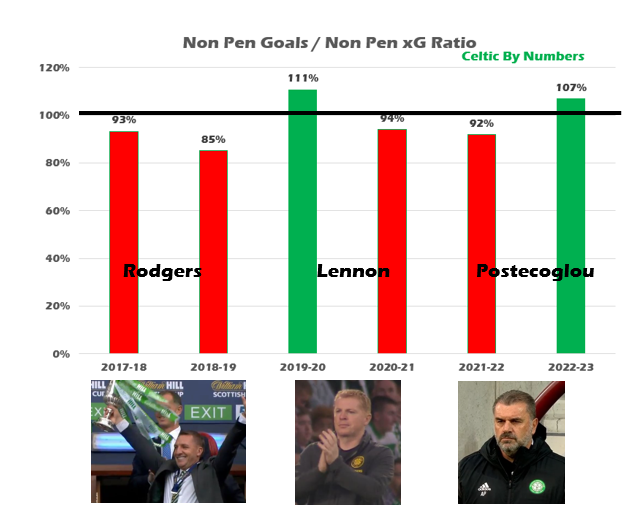90% of data analysis is cribbing good ideas from others, and don’t let anyone tell you otherwise!
In that spirit! This tweet from @eduinlatimer caught my eye this morning not just for the excellent topic and analysis but for the reaction amongst other data analysts.
Ostensibly it is noting a potential trend whereby Graham Potter managed sides seem to consistently underperform their xG.
Potter’s Less Than Magic Circle
This caught my eye because a) Potter was linked to the Celtic job, b) I admired his work at Ostersund SK and Brighton and Hove Albion and was intrigued as to why it did not work well at Chelsea and c) the analytical reaction that hell yeah maybe conformity to xG models isn’t just about “luck”.
That latter point is given further credence by the fact Lionel Messi consistently overperformed his xG season over season. xG models are predicated on the notion of the “average” striker and there has perhaps never been a less average striker of the ball than Messi.
Exceptions “breaking” the model does not necessarily invalidate the model as all models are guides not absolute predictors. In fact, it is reassuring when an exception is correctly highlighted within a model.
Back to Potter. It seems his teams consistently underperform their xG. The article posits this is due to the high percentage of blocked shots but does not go onto say why that is the case.
Back to Celtic, what are the trends in this regard, given a criticism of Brendan Rodgers’s first stint was a slide into more pedantic, patient football?
Celtic 17-18 to 22-23
Here’s the Celtic ratio of non-penalty goals to non-penalty expected goals per season for those I have records for:

Under Rodgers the first time the team increasingly underperformed relative to xG with his last season seeing the lowest 85% of xG being achieved as actual goals.
Under Neil Lennon that sprang up to an overperformance before falling back under parity in the 20-21 season.
Under Ange Postecoglou, first season underperformance gave way to the only other season the xG has been overshot in recent times.
No season comes close to the consistent ratio of around 70-80% underperformance Potter’s teams see and I would posit being within + or – 10% either way is difficult to attribute or arrive at a definitive conclusion.
An opinion would be that as mentioned above, Rodgers’s first Celtic side became more possession heavy and less penetrative over time.
When Lennon took over there was a greater emphasis on more aggressive and direct play, and the 19-20 season was one of the “everything comes together” type seasons before the dreadful 20-21 implosion.
Under Postecoglou it took a while for the attacking patterns to become efficient but in season two the team performed incredibly consistently as regards penetration and goal threat.
Let’s look at impediments to meeting the xG ratio.
Blocked Shots and Shots Outside Box
The stimulant article concentrated on blocked shots. I’d also have included shots outside the box.
Here are the trends together with the G/xG ratios:

Pleasingly both shots blocked and shots taken from outside the box are trending down over time.
This is partly due to the increase in data analysis I’d boldly assert! And would be consistent with trends in the English Premier League.
Poor shot selection includes shooting from over optimistic distances but also shooting when many defenders are in proximity and therefore the probability of being blocked is higher.
It might be Potter’s data is due to an over systemic / “positionist” principal of “we work the ball into areas X, Y or Z and then shoot”. I might be both over simplifying and overreaching with that suggestion. Feel free to add your own thoughts in the comments.
Summary
This isn’t one of these “big reveal” blogs. More musings on an interesting (to me at least) case study and assessment whether the same trends are evident at Celtic.
I’d say they are not but that it is interesting goal efficiency relative to xG coincidentally seems to be lower when a) a new manager is implementing ideas (21-22) or b) a system is becoming stale (18-19) or c) the bloomin’ wheels come off (20-21)!
“Good luck” seems to follow coherent and well-versed teams (Lennon 19-20) and Postecoglou (22-23).
So, the quicker Rodgers can get his Celtic team used to the desired attacking patterns, the “luckier” I suspect they will be relative to xG performance.

Re Postecoglu’s 2 seasons:
Kyogo missed a large portion of the 21/22 season
He’s not quite in Messi’s class but he’s certainly an “above average” striker and his increased number of appearances could certainly explain our uptick in Actual goals vs Expected Goals in season 22/23
Its true that Kyogo’s not quite in Messi’s class, but then again who is? I’d argue that these days, not even Lionel Messi’s in Messi’s class.
An excellent read again, Alan. My main concern when Rodgers was appointed was how the slower, less direct football would affect us in terms of goals. Obviously I mean domestically, as his adaptability may help us in CL especially after his experience with Leicester. It seems daft considering his side set a goals tally record l, but with our current squad and his style of play, I suspect we will see a drop-off in goals (hope I’m wrong). This could be a problem if it’s a tight race, so I’m really hoping I’ve misread things.